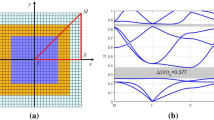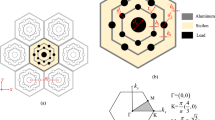Abstract
Phononic materials with specific band-gap characteristics at desired frequency ranges are in great demand for vibration and noise isolation, elastic wave filters, and acoustic devices. The attenuation coefficient curve depicts both the frequency range of band gap and the attenuation of elastic wave, where the frequency ranges corresponding to the none-zero attenuation coefficients are band gaps. Therefore, the band-gap characteristics can be achieved through maximizing the attenuation coefficient at the corresponding frequency or within the corresponding frequency range. Because the attenuation coefficient curve is not smooth in the frequency domain, the gradient-based optimization methods cannot be directly used in the design optimization of phononic band-gap materials to achieve the maximum attenuation within the desired frequency range. To overcome this difficulty, the objective of maximizing the attenuation coefficient is transformed into maximizing its Cosine, and in this way, the objective function is smoothed and becomes differentiable. Based on this objective function, a novel gradient-based optimization approach is proposed to open the band gap at a prescribed frequency range and to further maximize the attenuation efficiency of the elastic wave at a specific frequency or within a prescribed frequency range. Numerical results demonstrate the effectiveness of the proposed gradient-based optimization method for enhancing the wave attenuation properties.
Similar content being viewed by others
References
Sigalas, M.M. and Economou, E.N., Elastic and acoustic wave band structure. Journal of Sound and Vibration, 1992, 158: 377–382.
Kushwaha, M.S., Halevi, P., Dobrzynsi, L. and Djafari-Rouhani, B., Acoustic band structure of periodic elastic composites. Physical Review Letters, 1993, 71: 2022–2025.
Liu, Z., Zhang, X., Mao, Y., Zhu, Y., Yang, Z., Chan, C. and Sheng, P., Locally resonant sonic material. Science, 2000, 289: 1734–1736.
Martinsson, P.G. and Movchan, A.B., Vibrations of lattice structures and phononic band gaps. Quarterly Journal of Mechanics and Applied Mathematics, 2003, 6(1): 45–64
Sigalas, M.M., Kushwaha, M.S., Economou, E.N., Kafesaki, M. and Psarobas, I.E., Classical vibrational modes in phononic lattices: theory and experiment. Zeitschrift fur Kristallographie, 2005, 220: 765–809.
Zhang, K., Deng, Z.C., Xu, X.J., et al. Sympletic analysis for wave propagation of hierarchical honeycomb structures. Acta Mechanica Solida Sinica, 2015, 28(3): 294–304.
Jensen, J.S., Phononic band gaps and vibrations in one- and two- dimensional mass-spring structures. Journal of Sound and Vibration, 2003, 266(5): 1053–1078.
Jensen, J.S., Topology optimization problem for reflection and dissipation of elastic waves. Journal of Sound and Vibration, 2007, 301: 319–340.
Halkjær, S., Sigmund, O. and Jensen, J.S., Inverse design of phononic crystals by topology optimization. Zeitschrift fur Kristallographie, 2005, 220(9–10): 895–905.
Gazonas, G.A., Weile, D.S. and Wildman, R., Genetic algorithm optimization of phononic band gap structures. International Journal of Solids and Structures, 2006, 43(18–19): 5851–5866.
Rupp, C.J., Evgrafov, A., Maute, K. and Dunn, M., Design of phononic materials/structures for surface wave devices using topology optimization. Structural and Multidisciplinary Optimization, 2007, 32(2): 111–121.
Romero-García, Sánchez-Pérez, J.V., Sánchez-Pérez, L.M., et al., Hole distribution in phononic crystals: Design and optimization. Journal of the Acoustical Society of America, 2009, 125(6): 3774–3783.
Dong, H.W., Su, X.X., Wang, Y.S., et al., Topology optimization of two-dimensional asymmetrical phononiccrystals. Physics Letters A, 2014, 378(4): 434–441.
Hedayatrasa, S., Abhary, K. and Uddin, M., Numerical study and topology optimization of 1D periodic bio-material phononic crystal plates for band gaps of low order Lamb waves. Ultrasonics, 2015, 57: 104–124.
Zhong, H.L., Wu, F.G. and Yao, L.N., Application of genetic algorithm in optimization of band gap of two-dimensional phononic crystals. Acta Physica Sinica, 2006, 55(1): 275–280 (in Chinese).
Liu, Z.F., Wu, B. and He, C.F., Band-gap optimization of two-dimensional phononic crystals based on genetic algorithm and FPWE. Wave Random Complex Media, 2014, 24: 286–305.
Liu, Z.F., Wu, B. and He, C.F., The characteristics of optimal two-dimensional solid/solid phononic crystals. Chinese Journal of Solid Mechanics, 2015, 36(4): 283–289 (in Chinese).
Dong, H.W., Su, X.X., Wang, Y.S. and Zhang, C., Topological optimization of two dimensional phononic crystals based on the finite element method and genetic algorithm. Structural and Multidisciplinary Optimization, 2014, 50(4): 593–604.
Dong, H.W., Su, X.X. and Wang, Y.S., Multi-objective optimization of two-dimensional porous phononic crystals. Journal of Physics D: Applied Physics, 2014, 47(15): 155301.
Hussein, M.I., Hulbert, G.M. and Scott, R.A., Tailoring of wave propagation characteristic in periodic structures with multilayer unit cells. In: Proceedings of the 17th American Society of Composites Technical Conference, West Lafayette, Indiana, CRC Press, Boca Raton, Florida, 2002.
Hussein, M.I., Hamzak, K., Hulbert, G.M., Scott, R.A. and Saitou, K., Multiobjective evolutionary optimization of periodic layered materials for desired wave dispersion characteristics. Structural and Multidisciplinary Optimization, 2006a, 31(1): 60–75
Hussein, M.I., Hulbert, G.M. and Scott, R.A., Dispersive elastodynamics of 1D banded materials and structures: analysis. Journal of Sound and Vibration, 2006b, 289(4–5): 779–806.
Hussein, M.I., Hulbert, G.M. and Scott, R.A., Dispersive elastodynamics of 1D banded materials and structures: design. Journal of Sound and Vibration, 2007a, 307(3–5): 865–893.
Hussein, M.I., Hamza, K. and Hulbert, G.M., Optimal synthesis of 2D phononic crystals for broadband frequency isolation. Wave Random Complex, 2007b, 17(4): 491–510
Cox, S.J. and Dobson, D.C., Maximizing band gaps in two dimensional photonic crystals. SIAM Journal of Applied Mathematics, 1999, 59(6): 2108–2120.
Dahl, J., Jensen, J.S. and Sigmund, O., Topology optimization for transient wave propagation problems in one dimension—Design of filters and pulse modulators. Structural and Multidisciplinary Optimization, 2008, 36: 585–595.
Huang, Y., Liu, S.T. and Zhao, J., Optimal design of two-dimensional band-gap materials for uni-directional wave propagation. Structural and Multidisciplinary Optimization, 2013, 48: 487–499.
Park, J.H., Ma, P.S. and Kim, Y.Y., Design of phononic crystals for self-collimation of elastic waves using topology optimization method. Structural and Multidisciplinary Optimization, 2015, 51(6): 1199–1209.
Sigmund, O. and Jensen, J.S., Systematic design of phononic band gap materials and structures by topology optimization. Philos Trans R Soc Lond, 2003, 361: 1001–1019.
Halkjasr, S., Sigmund, O. and Jensen, J.S., Maximizing band gaps in plate structures. Structural and Multi-disciplinary Optimization, 2006, 32(4): 263–275.
EI-Sabbagh, A., Akl, W. and Baz, A., Topology optimization of periodic Mindlin plates. Finite Elements in Analysis and Design, 2008, 44: 439–449.
Diaz, A.R., Haddow, A.G. and Ma, L., Design of band-gap grid structures. Structural and Multidisciplinary Optimization, 2005, 29(6): 418–431.
Kevin, L.M., Michael, J.L. and Massimo, R., Topology design and optimization of nonlinear periodic materials. Journal of the Mechanics and Physics of Solids, 2013, 61: 2433–2453.
Author information
Authors and Affiliations
Corresponding author
Additional information
Project supported by the National Natural Science Foundation of China (Nos. 11502043, 11332004 and 11402046), the Fundamental Research Funds for the Central Universities Of China (DUT15ZD101) and the 111 Project (B14013).
Rights and permissions
About this article
Cite this article
Huang, Y., Liu, S. & Zhao, J. A gradient-based optimization method for the design of layered phononic band-gap materials. Acta Mech. Solida Sin. 29, 429–443 (2016). https://doi.org/10.1016/S0894-9166(16)30245-2
Received:
Revised:
Published:
Issue Date:
DOI: https://doi.org/10.1016/S0894-9166(16)30245-2




